Oil switch: types, marking + specifics of use
Among the switching equipment, an honorable place, like a veteran, is occupied by an oil switch used in both indoor and outdoor switchgears of any voltage.
Its main function is to enable or disable individual lines of a normally working electrical system or in non-standard situations. Shutdown, depending on the circumstances, occurs automatically or manually.
In this article we will consider the existing types of these devices, their classification and labeling. We also pay attention to the pros and cons of such switches, features and rules for their use. For a better understanding of the material, we selected diagrams, tables, visual photos and thematic video reviews.
The content of the article:
Pros and cons of oil switches
These devices have a relatively simple design. They have a good breaking capacity, do not depend on weather conditions. If a malfunction occurs, repairs can be carried out. Tank MVs are suitable for outdoor installation. There are conditions for mounting built-in current transformers.
An important role in the work of MV is played by the speed of contact divergence. A situation may arise when the contacts diverge at great speed and the arc instantly reaches a length that is critical for it. In this case, the magnitude of the recovering voltage may not be enough to break through the contact gap.
Disadvantages are more with tank switches. The first is the presence of a large volume of oil, therefore, the considerable dimensions of these units and switchgears. The second - fire and explosion hazard, in emergency situations, the consequences can be the most unpredictable.
The oil level in the tank and in the inlets, as well as its condition, must be kept under periodic control. If there is MV in the served power supply networks, it is necessary to have a special oil facility.
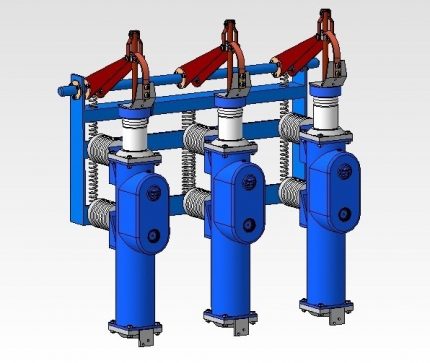
Classification of oil circuit breakers
The use of oil switches began at the end of the century before last. Almost until the middle of the twentieth century, there were simply no other disconnecting devices in high-voltage networks.
There are two large groups of these devices:
- Tankfor which the presence of a large volume of oil is characteristic. For this equipment, it is both the environment in which the arc is extinguished, and insulation.
- Low-oil or low-volume. The amount of filler in them says the name itself. These switches contain dielectric elements, and the oil here is only necessary for extinguishing.
The former are mainly used in distribution installations from 35 to 220 kV. The second - up to 10 kV. BMT low-oil devices are also used in outdoor switchgears designed for 110 and 220 kV.
The principle of arc extinction is identical in both types. The arc that appears when the high-voltage contacts of the switch are opened causes rapid evaporation of the oil. This leads to the creation of a gas shell around the arc. This formation consists of oil vapor (about 20%) and hydrogen (H2).
The arc gap is deionized as a result of rapid cooling of the arc barrel by mixing high and low temperature gases in the shell.
At the moment of arcing in the contact zone, the temperature is very high - about 6000⁰. Depending on the installation, the circuit breakers are used for indoor and outdoor use, as well as for use in switchgear - complete switchgears.
View # 1 - tank type equipment
Switching equipment of this type may have one tank or more depending on voltage. In the first case, it is up to 10 kV, in some cases up to 35. Each phase of the circuit breakers operating in installations with high voltage is placed in an individual tank.

The drives to both tank and low-oil circuit breakers can be manual, automatically assembled on the solenoid switching coil or spring-mounted. In the second case, the magnetic property of the solenoid is used, which makes it possible to tighten the metal core connected by means of a special system to the MV shaft.
When an electric direct current solenoid is supplied to the winding, the unit is turned on by retracting the core of the magnetic circuit with subsequent rotation of the circuit breaker shaft.
A special latch holds the shaft in this position. Simultaneously with switching on, the solenoid sets a definite position for disconnecting springs, which, when a special electrical impulse arrives, disconnect the MV.
The shutdown process starts the second solenoid by knocking out the roller mechanism (latch). As a result, the shaft instantly rotates due to the spring and shuts off. For the operation of the solenoid drive, the presence of a battery is required to supply it with direct current.
When the battery is missing, a spring drive is used. The inclusion is performed using an electric motor or due to muscular effort. Manual shutdown is possible for low-power units with a short-circuit current value up to 30 kA, for shutting down of which a maximum force of 25 kg must be applied.
Single tank MV with open arc
In some switchgears, tank switches are installed that do not have arcing chambers. The electric arc here is extinguished in the simplest way - by double breaking the contacts in an oil-filled container. Such devices with an open arc include domestic models of VMB and VME. They are rated for a rated current of 1.25 kA.
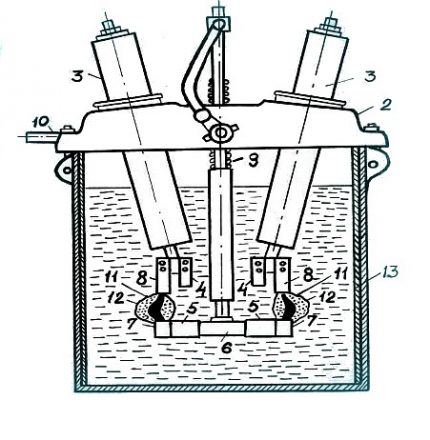
The symbol "E" stands for excavation, the number 6 is the voltage rating of 6 kV, 200 is the rated current in amperes. The threshold breaking current for this MV is 1.25 kA. The tank of this MV is made of steel and connected to the lid of cast iron by means of bolts. The walls of the tank are covered with insulation (13).
Six porcelain insulators passing through the lid end with copper brackets that serve as fixed working contacts. The VME series has a manual flywheel drive.
There are movable contacts on the traverse or contact bridge. Arcing mobile contacts in the form of brass squares are also located here. Copper plates with brass ends located below at the ends of the insulators are fixed arcing contacts. The insulating rod through the contact with the drive mechanism communicates the movement of the movable contacts.
When the traverse is raised, the fixed contacts are closed, the spring responsible for disconnecting is compressed, the MV is on. The switch is connected to the latch drive shaft, which holds it in position. At any disconnection, the latch is released, the spring opens, and the yoke swiftly follows down. In this case, a sequential opening of the working contacts occurs: 4 and 5, then 7.8.
This causes, at each pole of the circuit breaker at two points, the appearance of an arc and the decomposition of oil. Inside the shells 12, the pressure reaches from 0.5 to 1 MPa, thereby activating the deionization process. Within a maximum of 0.1 s, the arcs are extinguished, and the shells, rising, appear under the lid and increase the volume of the air cushion.

The latter acts as a buffer, reducing the impact force in the process of extinguishing. The normal height of the airbag is approximately 25% of the volume. Exceeding this threshold may cause an explosion.
Such switches are easy to operate, relatively inexpensive, and convenient to use in open substations. But hot oil vapors, even with simple contact with oxygen, are easily ignited.
Arc burning in an oil medium starts the polycondensation process, which degrades the electric strength of the oil. The tank clogs the sediment, consisting of carbon particles. Therefore, revisions of the unit with oil change are necessary.
Oil circuit breakers with interrupter chamber
The breaking capacity and reliability of the tank-type circuit breakers significantly increases the presence of the arcing chamber. It is placed in the oil in the tank. In three-tank circuit breakers, each phase is located in a separate tank.
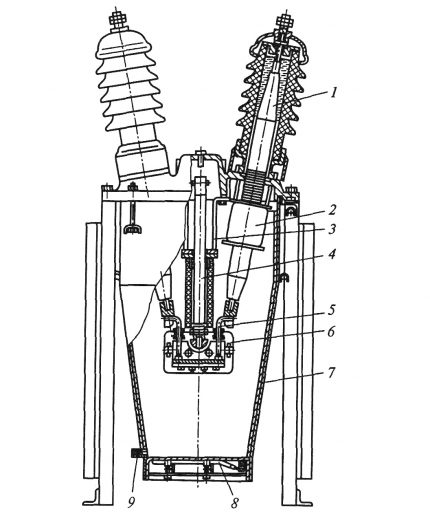
The design is more complicated than that of a VM without arcing chambers and consists of:
- poles (1);
- current transformer (2);
- drive housing (3);
- rods (4);
- stationary contact (5);
- arc chamber (6);
- isolation (7);
- heating element (8);
- oil drain devices (9).
The top of the camera is equipped with a fixed contact. When turned on, a moving contact, having the form of a rod, penetrates into it. In the event of a trip, the rod leaves a stationary contact, as a result of which an arc appears in the chamber. The pressure that arises in this case is an order of magnitude higher than the corresponding parameter for switches that are not equipped with an arcing chamber.
The pressure of 8 -7 MPa reduces the diameter of the arc, increases the breakdown strength of the gap after the current passes through the zero mark. As a result, a faster arc extinction process occurs. Following the exit of the movable contact from the chamber, an exhaust gas with a partial capture of oil follows through a free hole.
The barrel of the arc is rapidly cooled, intense deionization occurs. With increasing current, the efficiency of the arcing chamber increases. MV can also work as equipment with an open arc in case of disconnection of small currents.
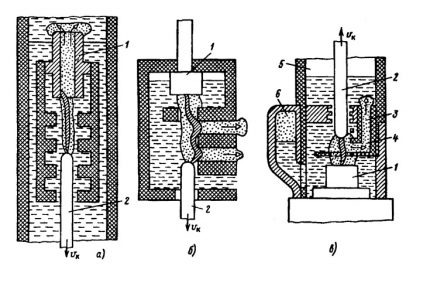
The type of automatic blasting is determined by the design of the arcing chamber. In the first case, the vapor mixture vector has a longitudinal direction with respect to the arc shaft (fragment a). With a transverse orientation, the sulk flow moves in a direction perpendicular to the arc column or at a certain angle (fragment b).
In the case when the flow stream has a direction opposite to the vector of motion of the mobile contact with the arc, there is a counter blast. Combinations of these methods are often used in arcing devices.
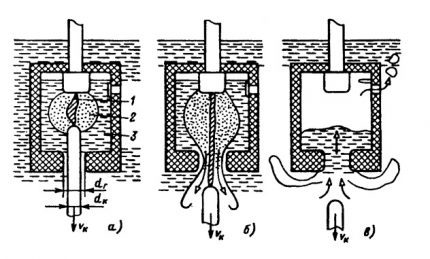
At the last stage, the camera is preparing to participate in the next shutdown cycle. For automatic restart, this step is extremely important.
View # 2 - pot or low oil circuit breakers
In indoor installations, potty switches are used as generator and distribution. In the open - as substation and distribution. Oil does not perform insulation functions in switches of this type; it is necessary only as a medium for extinguishing the arc.
The fire and explosion hazard of low-volume VMs is significantly lower than that of tank ones. Install them both in the switchgear and in the switchgear of any voltage up to 110 kV. The role of insulation of poles in relation to each other and the earth is performed by dielectrics such as porcelain, cast resin, steatite.
The oil in these VMs occupies only 3 to 4% of the pole volume. Small oil volume, light weight and convenient dimensions are the indisputable advantage of this equipment. However, they are used in such nodes of the system, where the switches do not have high requirements.
These limitations are explained by the strong connection of the disconnecting ability with the disconnected current, the inability of the structure to work in conditions of frequent shutdowns.
Another reason is the difficulty in implementing multiple high-speed ARs. In low-volume circuit breakers, the following types of oil blast are used: transverse, longitudinal, mixed. Experts consider the first of them to be the most effective.
For switches of this type, designed for indoor switchgear, the contacts are placed in a steel tank. MV voltage of 35 kV and higher have a shell made of porcelain. The most used equipment is suspended 6-10 kV. Its body is fixed on a common frame for all poles. All three poles have an arcing chamber, each is designed for one open contact, and at high voltages by 2 or more.
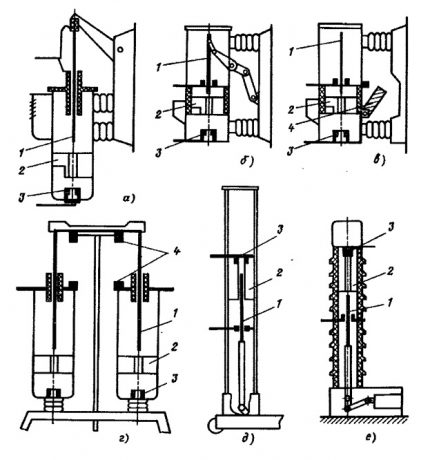
According to the above scheme, VMP, VMG, MG circuit breakers are designed for voltages up to 20 kV. A design feature of circuit breakers for high-rated currents is that working contacts are located outside, and arcing contacts inside the tank.
VMP series circuit breakers are often used in closed devices, as well as switchgear 6-10 kV. In the complete switchgear, the VK series switches are installed. They are equipped with a built-in electromagnetic or spring drive, and are designed for breaking currents of 20 - 31.5 kA and current ratings of 630 - 3150 A.
Column switches manufactured specifically for switchgear are distinguished by sliding design. In 35 kV installations, column-type VMs of the VMK and VMUE series are installed. Switchgear 110, 220 kV equipped with switches of the BMT series. The unit has a welded base on which its three poles are placed. Management - spring drive.
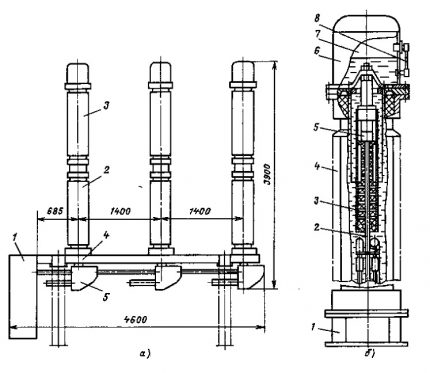
The module is shown on the right side of the photo, where: 1 is the collector, 2 is the movable contact connected to the collector through collectors. The interrupter chamber is indicated by number 3, the fixed contact is 5. All of the above are placed in a hollow insulator (4) made of porcelain. Inside it is transformer oil, and on top is a cap (6).
The latter is equipped with a pressure gauge for the possibility of monitoring the pressure in the module. In addition, the lid has a unit for filling with compressed gas mixture, an automatic exhaust valve, and an oil indicator (8). The mobile contact and the control device are connected by insulating rods.
The design of the pole is identical for the entire series of switches. In the MV tanks for current ratings from 630 to 1600 A, there are 5.5 kg of oil, above 1600 and up to 3150 A inclusive - 8 kg.
To increase reliability, the design of individual circuit breakers additionally includes control and protection elements:
- disconnecting electromagnets;
- relays acting instantly and with a shutter speed at a threshold current;
- undervoltage relay;
- additional contacts.
Depending on the layout method, there are low oil circuit breakers with a lower arrangement of the arcing chamber and the opposite - upper. In the first case, the movable contact implements the movement from top to bottom, in the second - vice versa. Breaking capacity of the latter is higher.
Marking of oil switches
The decoding of the markings made by the manufacturer on the oil switch will allow you to get acquainted with the basic information about it. Let us examine for example the marking of the VMG-133 switch. The first character "B" indicates that you have a switch.

Second - "M" indicates the type of switch, in a particular case - low oil. Letter "G" determines belonging to a certain species - potted. 133 - Series MV.
MV operating rules
Repair, operational personnel, specialists associated with the maintenance and operation of oil circuit breakers are required to know the relevant instructions, device, principle of operation of the equipment.
The employees serving the MV during operation are required to control:
- Effective voltage, load current. Indicators should not go beyond tabular values.
- The height of the oil column at the poles, the absence of leaks.
- The presence of grease on the rubbing parts. The contacts may lose mobility and freeze if the lubrication of the rubbing elements becomes thick and dirty.
- The dustiness of the rooms in which the switchgear is located.
- Compliance of mechanical characteristics of operated circuit breakers with table standards.
After each shutdown, short circuit need to inspect the equipment. Information about these outages is recorded in a special log. A defect log must be available to record information about malfunctions detected during operation of the unit. The switch on which a trip as a result of a short circuit occurred is subject to inspection.
Check for oil spills. If this happened, moreover in large quantities, then this indicates an abnormal shutdown of the short circuit. Equipment is taken out of service and inspected. When the oil is dark, a change is needed.The opening speed is adversely affected by the viscosity of the oil, which increases when the temperature drops.
Sometimes it becomes necessary to replace the old grease during the repair with a new one: TsIATIM-221, GOI-54 or TsIATIM-201.
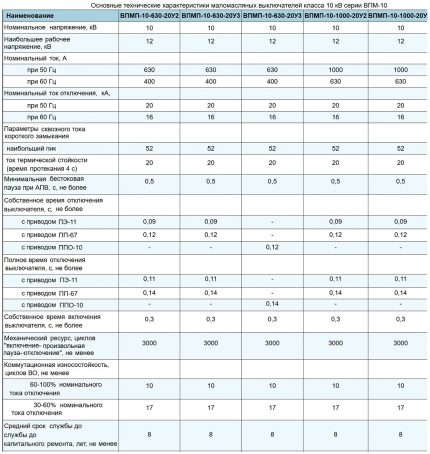
After the MV has been taken out of operation, support insulators, rods, insulation of the tanks for cracks are subject to a thorough inspection. Heavily soiled insulation is wiped. The need for an extraordinary repair appears after a certain amount of short circuit.
Periodic inspection (ON) is performed monthly. In this case, pay attention to the degree of heating of the switch. TR (current repair) is carried out annually. It includes such tasks as checking and fixing fastener defects, drive kinematics, oil level, seals. Insulating parts are also checked for their integrity.
After 3-4 years after a major overhaul, perform an average (SR). It includes the whole range of TP operations plus additionally measures the transition resistance of the poles and checks the mechanical and speed parameters.
In case of detection of inconsistency of the controlled characteristics with the tabular data, the circuit breaker is disassembled, the adjustment and a full range of high voltage tests are performed.
During an extraordinary repair, they mainly try to leave the previous adjustment unchanged. For this reason, the circuit breaker is disassembled to a minimum. The frequency of overhaul is from 6 to 8 years. In its scope, a general inspection is carried out, cylinders are removed from the frame, the tires are disconnected, the drive, arcing devices, and block contacts are repaired.
After all, make adjustments, paint, connect tires, conduct tests. For all work draw up documentation.
In addition to oil type circuit breakers, other disconnecting devices are also used in high-voltage networks. For example, gas and vacuum. We have other articles on our site that detail the characteristics and design of these types of switches, as well as the features of their use:
- Vacuum switch: device and principle of operation + nuances of choice and connection
- Gas-insulated switches: reference points and connection rules
Conclusions and useful video on the topic
The device, types, purpose and operation of the MV:
Detailed review of the VMP-10:
All basic requirements for circuit breakers operating under high voltage conditions are also met by oil circuit breakers. Most of them are safe and reliable in operation, provide quick shutdown, easy to install. Despite this, manufacturers are striving to ensure even greater compliance with the requirements put forward by MV.
Do you have knowledge of oil circuit breakers and want to supplement the material presented with useful information? Maybe you noticed a mismatch or error? Or do you have questions about the topic? Please write to us about this under the article - we will be grateful to you.

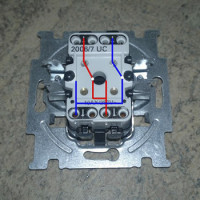 Rocker switch: marking, types, connection features
Rocker switch: marking, types, connection features  Touch light switch: why is it needed, types, marking, selection and connection
Touch light switch: why is it needed, types, marking, selection and connection 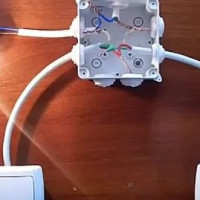 How to choose a passage switch: device and purpose of various types + marking
How to choose a passage switch: device and purpose of various types + marking 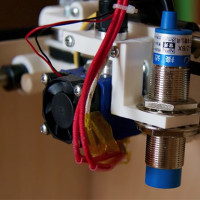 Why do I need a proximity switch + marking and features of its connection
Why do I need a proximity switch + marking and features of its connection 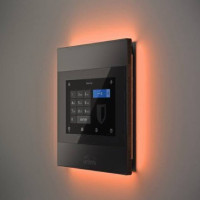 Smart switches: types, labeling, how to choose and connect correctly
Smart switches: types, labeling, how to choose and connect correctly  Light switch with remote control: types + overview of TOP brands
Light switch with remote control: types + overview of TOP brands  How much does it cost to connect gas to a private house: the price of organizing gas supply
How much does it cost to connect gas to a private house: the price of organizing gas supply  The best washing machines with dryer: model rating and customer tips
The best washing machines with dryer: model rating and customer tips  What is the color temperature of light and the nuances of choosing the temperature of the lamps to suit your needs
What is the color temperature of light and the nuances of choosing the temperature of the lamps to suit your needs  Replacement of a geyser in an apartment: replacement paperwork + basic norms and requirements
Replacement of a geyser in an apartment: replacement paperwork + basic norms and requirements
Please tell me, what is the difference between VMP oil switches and VPM?
The scope of VPM (and its predecessor VMG) is in indoor installations, and VMP is in indoor switchgears, as well as switchgear 6-10 kV.
To make it more clear, I’ll explain a little more. For example, VMP-10 and VPM-10. Both switches are of the type of low oil, implemented in the form of three-pole switching devices. VMP-10 and VPM-10 are designed for operation in closed installations with high-voltage alternating current. The difference lies in the design features and installation methods. Attaching photo.